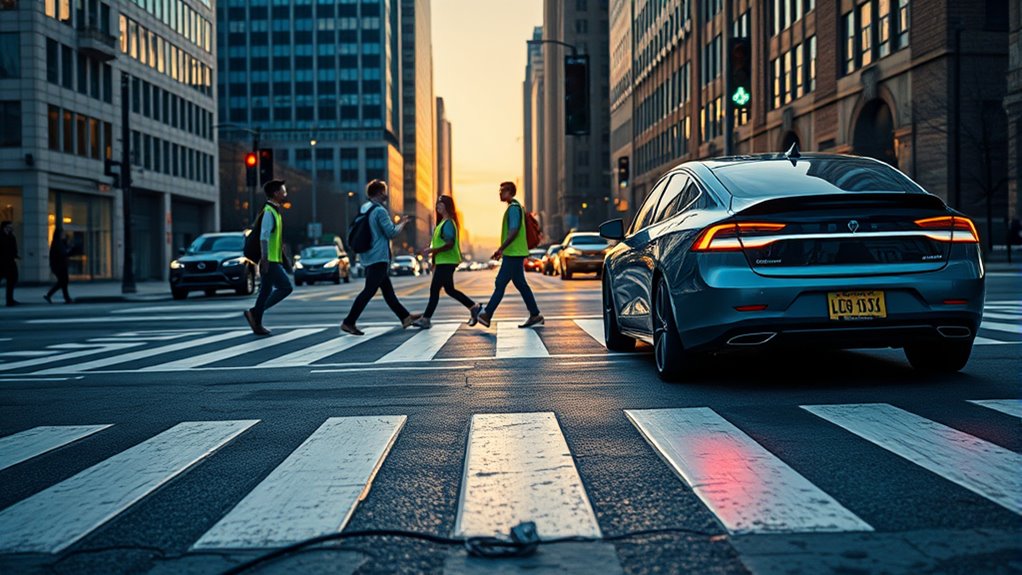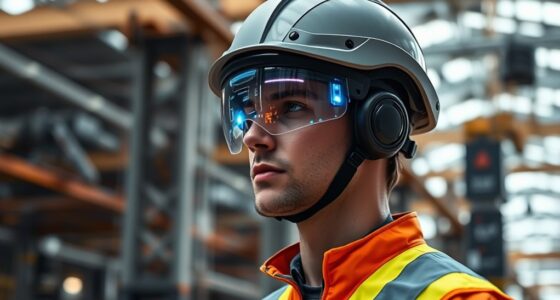Advancements in vehicle and sensor technologies have greatly boosted transportation safety by improving pedestrian detection and accident prevention. Modern autonomous systems use cameras, lidar, and radar to identify pedestrians quickly and act swiftly to avoid collisions. These innovations help reduce urban accidents, even in adverse weather or complex environments. As technology continues evolving, you’ll discover how future developments will make pedestrian safety even more reliable and accidents less frequent, keeping everyone safer on the road.
Key Takeaways
- Autonomous vehicle sensors like lidar, radar, and cameras enhance detection of pedestrians and surrounding objects.
- Advanced machine learning algorithms improve accuracy in identifying pedestrians and predicting their movements.
- Integrated safety features such as automatic braking and emergency stops reduce collision risks in urban environments.
- Sensor technology advancements enable reliable operation in adverse weather conditions, ensuring continuous pedestrian protection.
- Future developments include 360-degree perception and better sensor integration for comprehensive safety coverage.

Transportation safety is essential for protecting lives and ensuring smooth travel experiences. As technology advances, one of the most promising developments is the rise of autonomous vehicles. These vehicles are designed to navigate roads without human input, relying heavily on sophisticated sensors and software. One critical feature that enhances their safety is pedestrian detection. With pedestrian detection, autonomous vehicles can identify people walking nearby, even in complex environments or low visibility conditions. This capability allows the vehicle to react swiftly, slowing down or stopping to prevent accidents. Pedestrian detection systems typically use a combination of cameras, lidar, radar, and machine learning algorithms to accurately distinguish pedestrians from other objects. This technology not only saves lives but also builds trust in autonomous driving, encouraging wider adoption.
Autonomous vehicles use pedestrian detection to identify and react to pedestrians, enhancing safety and building trust in self-driving technology.
When you’re sharing the road with autonomous vehicles, pedestrian detection plays a crucial role in creating safer interactions. The vehicle constantly monitors its surroundings, scanning for pedestrians crossing the street or walking along the roadside. If a pedestrian suddenly steps into the vehicle’s path, the system immediately alerts the vehicle’s control unit to take action. This rapid response time minimizes the risk of collisions, especially in busy urban areas where unpredictable pedestrian movement is common. Furthermore, pedestrian detection is integrated with other safety features such as automatic braking and emergency stop functions, providing a layered defense against accidents.
You’ll notice that these advancements not only protect pedestrians but also improve overall traffic flow. Autonomous vehicles equipped with pedestrian detection can operate more confidently in mixed environments, reducing abrupt stops or unpredictable maneuvers that can cause congestion or secondary accidents. They’re programmed to prioritize safety, adhering strictly to traffic laws and adjusting their behavior to the presence of pedestrians. This creates a safer environment for everyone on the road, including vulnerable pedestrians, children, and the elderly. Additionally, the use of advanced sensors in pedestrian detection can help compensate for adverse weather conditions, ensuring safety even in rain or fog.
As these technologies continue to evolve, so does the potential for even more enhanced safety features. Future autonomous vehicles may include 360-degree pedestrian detection, better prediction models for pedestrian movements, and improved sensory integration to handle adverse weather conditions. The goal is to create a transportation system where accidents involving pedestrians become a rarity. By focusing on advancements like autonomous vehicles with pedestrian detection, the future of transportation looks safer, more reliable, and more inclusive for all road users. Your awareness of these innovations helps you understand the importance of ongoing technological progress and its role in protecting lives on every journey.
Frequently Asked Questions
How Do Vehicle Safety Features Perform in Extreme Weather Conditions?
In extreme weather conditions, vehicle safety features may face visibility challenges, impacting sensor reliability. You might notice that sensors struggle with snow, fog, or heavy rain, reducing the effectiveness of collision avoidance systems. While advanced sensors are designed to adapt, harsh weather can still hinder their performance. Staying alert and driving cautiously is essential, as technology isn’t foolproof in these situations.
What Are the Latest Pedestrian Detection Technologies Available?
Imagine a vigilant guardian watching every step—latest pedestrian detection tech acts like that. You’ll find smart crosswalks equipped with sensors that detect pedestrians and trigger flashing lights or signals. Wearable alert systems, like smart bracelets, notify both drivers and pedestrians of each other’s presence. These innovations create a safer environment by dramatically reducing accidents, ensuring you can cross streets confidently, knowing advanced tech has your back at every step.
How Effective Are Current Vehicle Crash Test Ratings Worldwide?
You’ll find that current vehicle crash test ratings worldwide are quite reliable due to strict crash test standards. These standards ensure consistent rating methods across different regions, helping you compare vehicle safety effectively. While ratings aren’t perfect, they give you a solid idea of a vehicle’s crashworthiness. Overall, they’re effective tools for making safer choices, especially when you pay attention to rating consistency and specific crash test results.
What Impact Do Autonomous Vehicles Have on Overall Traffic Safety?
Did you know autonomous vehicles could reduce traffic accidents by up to 90%? They substantially improve overall traffic safety by eliminating human errors like distracted driving. However, you should consider autonomous vehicle ethics and AI decision making, which influence how these cars respond in complex situations. As a result, they have the potential to make roads safer, but it’s essential to address ethical dilemmas and improve AI systems for maximum safety benefits.
Are There Specific Safety Measures for Vulnerable Pedestrian Populations?
You should prioritize sidewalk safety and crossing assistance for vulnerable pedestrians. Implementing features like raised crosswalks, audible signals, and improved lighting helps keep them safe. Crossing assistance technologies in vehicles, such as automatic braking and pedestrian detection, also protect these populations. By focusing on these measures, you create a safer environment, reducing accidents and ensuring that vulnerable pedestrians can navigate streets confidently and securely.
Conclusion
By now, you see how advanced vehicle and pedestrian protections are making roads safer. Some might think these technologies are too costly or unnecessary, but consider the lives saved and accidents prevented. Investing in these safety measures benefits everyone, reducing injuries and saving money in the long run. So, don’t overlook these innovations—they’re essential for a safer, smarter transportation future that protects you and your loved ones every day.









